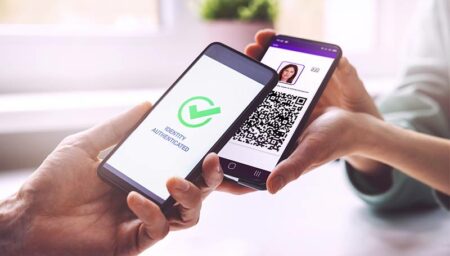Proving your identity with a smartphone

For many years now, biometric technologies are being developed to create safe and secure ways for citizens to authenticate their identities remotely. The pandemic escalated the need for the widespread implementation of these technologies. Let us take a look at four key areas where the pandemic pushes the innovative approaches of the biometrics industry.
Due to lockdowns, obtaining citizen rights such as pensions, renewal of ID documents etc., became incredibly difficult. Many people resorted to exchanging sensitive information with authorities via email and other unsecure channels of communication. This provided malevolent individuals with the ideal opportunity for ID theft and various other ID-related frauds.
One of the ways for governments to counter administrative backlogs, delays, and ID fraud is by modernizing their infrastructure through the implementation of secure remote services backed by biometric technologies.
To securely access eServices each citizen needs a digital ID created that is based on a trusted source of information: either a national database or a government-issued ID document. This ensures that the digital ID is rooted with the civil ID. It can either be issued directly in the national database or derived on the citizen’s smartphone. The digital ID can contain the citizen’s biographical and biometric data, and is used to verify their identity remotely to both public and private sector service providers.
In 2021 and onwards, governments will move quickly from assessing the options to the actual implementation and widespread usage of eServices.
Touchless technologies are paramount in limiting the spread of pandemics. Innovations allowing contactless fingerprint and iris scanning on-the-move are replacing current systems.
The touchless journey starts even before a traveler makes their way to the airport. Travelers can use the airport/airline app to check-in for their flight, add bags, and pay any applicable fees. This limits crowds, queues, and other traveler movements at the airport.
A traveler’s biometric data—be it their face, iris or fingerprints—can double as their unique identifier. Travelers register their biometric data using the airport/airline system. They then pass through the various contactless touchpoints using their unique identifier. Contactless biometric technologies create a seamless, hygienic and convenient journey for all travelers.
In order for employees to return to work safely, many companies have replaced simple access badges in favor of the accurate, fast, and convenient authentication provided by contactless biometric devices. Based on fingerprint scanning or face recognition, the terminals ensure that authorized personnel never touch the sensor or any hardware element of the machine in order to enter the premises.
In an ideal world, the issue of discriminatory algorithms would be easily resolved through the use of extensive and varied training data. In reality, training data is limited, and a balanced dataset does not necessarily result in a perfectly unbiased algorithm, which means that certain algorithms may not exhibit the same behavior for different human traits. But innovative approaches—such as changing the way the algorithm learns on a given dataset by tweaking relative importance of under or over-represented categories—now allow Artificial Intelligence to overcome this challenge.
2021 sees an increase in the ability of biometric algorithms to recognize all people equally regardless of their gender, age, and ethnicity. Biometric service providers can now ensure fair and successful use of facial biometrics. The biometrics industry is scaling up to develop algorithms that can withstand critique and produce accurate results for everyone to ensure citizens and governments benefit from the advantages of facial biometrics. In addition to this effort to achieve unbiased behavior, strides will be made towards openly sharing the inner workings of Artificial Intelligence, thereby increasing trust and transparency in rolling out biometric technologies.
Biometric data is extremely sensitive information that must be protected. Governments need to ensure that citizens’ data is captured, processed, and stored securely. However, this is not a simple process and governments require complete comprehension of how biometrics, along with other confidential citizen data, is managed and stored. Industry experts accompany governments in the process of educating themselves and their citizens. Once governments are confident that the data is protected, they can then share this certitude and confidence to increase acceptance at the citizen level.

Latest News